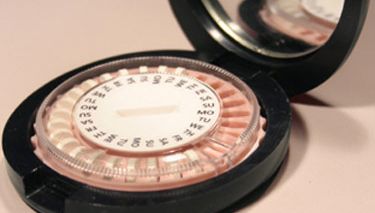Your Best Birth Control
Scared of weight gain? Hate the idea of hormones? Want more spontaneity with sex? Don't compromise on your contraceptive. Find the perfect one for you: Take This Birth Control Quiz

The Options, Made Easy
The Pill
What it is: Twenty-one prescription tablets containing a combination of estrogen and progestin—or, less frequently, progestin alone—along with seven or so hormone-free "placebo" pills that help you stay on your schedule.
How it works: The most common pills are combination versions, which prevent ovulation and thicken the cervical mucus so sperm can't make it into the uterus. Which formulation is right for you: monophasic, with constant doses of hormones throughout the cycle, or triphasic, which gives you different doses throughout the month? Or should you try Yaz, a pill with a special progestin that might nix bloat, pimples, moodiness, and other side effects? Unfortunately, trial and error is the only way to know—but most pills are similar to each other, and many women like the first type they try.
Doctors prescribe progestin-only pills more rarely—usually for smokers over 35 and other women prone to clot problems. These so-called mini pills work mainly by thickening cervical mucus and by helping to reduce ovulation. The bottom line is that if one pill doesn't work for you, don't assume none of them will.Caveats: Not recommended if you smoke or have an immediate family history of blood clots (though your doctor may let you go for the mini pill). The mini pill is marginally less effective than combination pills (estrogen makes them better at preventing ovulation), and you have to take it at the same time every day without fail. All pills can cause spotting at first, but this can be a constant issue for mini-pill users.
Failure rate: .3 percent with perfect use; 8 percent with typical use.
Cost: $15 to $35 per month.
How soon you can get pregnant: One to three months after stopping.
The Vaginal Ring
What it is: Available by prescription, the Nuva-Ring releases estrogen and progestin directly into the vaginal walls.
How it works: Insert this flexible ring (about two inches in diameter) into your vagina by squeezing the edges together, and remove it after three weeks—at which point you should get your period. Each ring works for one month, preventing fertilization the same way combination pills do. The ring is better for women who've experienced nausea with the Pill, since its hormones aren't absorbed through your GI tract, says contraception expert Régine Sitruk-Ware of the Population Council.
Caveats: Since your bloodstream takes in roughly the same dose of hormones as it does with the combination pill, side effects are similar—with the added risk of vaginal irritation, which often goes away within a few months. You might have heard stories about guys feeling the ring during sex, but that's a rare 1 percent of the time, says Hope Ricciotti, a Harvard Medical School women's-health expert.Failure rate: Less than 1 percent with perfect use; 8 percent with typical use.Cost: $30 to $45 per month.
How soon you can get pregnant: About two to four weeks after removal.
Ortho Evra Patch
What it is: Just one more way of delivering that progestin-estrogen cocktail. This prescription adhesive strip (about two inches square) releases hormones into the skin when placed on your torso, arm, stomach, or butt. Women who hate taking pills every day tend to love the patch.
How it works: You apply a new patch every week for three weeks. You get your period during the fourth, patch-free week.
Caveats: The FDA issued a warning stating that the Ortho Evra patch delivers 60 percent more estrogen than the average Pill (increased estrogen exposure is associated with elevated blood-clot risk). While experts continue to crunch numbers to figure out where the patch falls on the safety spectrum (some studies say risks increase, some don't), you need to weigh the convenience of the delivery system with the possible downside. Other drawbacks: While there's no data showing the extra estrogen causes more water retention, some patch users say their pants do feel a tad tighter. The patch also only comes in a peachy-pink color, so it won't blend with all skin tones.
Failure rate: .3 percent with perfect use; 8 percent with typical use.
Cost: $30 to $40 per month.
How soon you can get pregnant: One to three months after stopping.
The Sponge
What it is: Made famous by Seinfeld's Elaine and discontinued in 1995, the Today sponge is back. It's really just a cleaner way to use spermicide: The comfortable foam device can be inserted hours before sex and left in for up to 30 hours afterward.
How it works: It releases spermicide when moistened with water and placed over the cervix.
Caveats: It doesn't guard against STDs, and it can irritate the vagina, making you more vulnerable to microbes. Recommended: combining the sponge with a condom.
Failure rate: 9 percent with perfect use; 16 percent with typical use. If you've had a child, 20 percent with perfect use; 32 percent with typical use.
Cost: $7.50 to $9 for a package of three.
How soon you can get pregnant: Immediately after stopping.
Female Condom
What it is: A long plastic pouch with rings at each end-an open one for his penis and a closed one designed to hold the de-vice by your cervix. How it works: To insert, squeeze the edges of one ring together and insert deeply into the vagina; let the other ring hang outside the body.
Caveats: This contraption is decidedly unsexy-even our doctors admitted that they don't know a soul who actually uses it.
Failure rate: 5 percent with perfect use; 21 percent with typical use.
Cost: About $2.50 each.
How soon you can get pregnant: Immediately after stopping.
Diaphragm and Cervical Cap
What it is: The diaphragm is a flexible latex cup that sits over the cervix. The silicone FemCap is similar but smaller. The diaphragm comes in many sizes (the cap, only three), so your chances of a good fit are better.
How it works: Coat it with spermicide, fold it in half, and push inside the vagina until it covers the cervix. The spermicide immobilizes his swimmers, and the cap physically blocks the opening to the uterus. You must leave it in for at least six hours following sex-and remove it within 24 hours (48 hours for the cap) to reduce the risk of a bladder infection.
Caveats: Pregnancy and delivery change the shape and size of the cervix, so failure rates go up drastically after kids, especially with the cap. Both are a no-go if you're allergic or sensitive to spermicides. If you're prone to bladder infections, the cap is a better choice.
Failure rate: Diaphragms: 6 percent with perfect use; 16 percent with typical use.
Caps: 9 percent with perfect use; 16 percent with typical use. If you've had a child, 26 percent with perfect use; 32 percent with typical use.
Cost: $15 to $75, plus the cost of a doctor's exam.
How soon you can get pregnant: Immediately after stopping.
Sterilization
What it is: Permanent birth control, usually either tubal ligation ("having your tubes tied") or the Essure procedure, which involves placing tiny coils into the fallopian tubes.
How it works: Tubals are done laparoscopically under local or general anesthesia. Fallopian tubes are closed off so that eggs can't reach the uterus. With Es-sure, doctors only numb the cervix be-fore inserting soft metallic coils into the tubes.
Caveats: Complications of anesthesia or bleeding problems are rare but possible with tubals. Essure is considered safer, though complications can in-clude improper placement or expulsion of the coils, or perforation of the uterus.
Failure rate: About 1 percent for tubals; less than 1 percent for Essure. Failure can result in ectopic pregnancy, which requires emergency surgery.
Cost: $1200 to $3000 for Essure; $2500 to $4000 for tubal ligation.
How soon you can get pregnant: You can't; that's the point.
Natural Family Planning
What it is: No hormones, no inserting. Track your monthly fertility cycle and abstain accordingly.
How it works: Chart your hormonal ebbs and flows using a basal body thermometer (more sensitive than the conventional kind), a calendar, and your own finger to test your cervical fluids. Slippery mucus indicates fertile days; the sticky kind probably means you're safe.
Caveats: This method requires obsessive record keeping, and if you can't tell sticky from slippery-or are too squeamish to try-forget it.
Failure rate: Between 2 and 9 percent with perfect use; more like 25 percent with typical use.
Cost: None.
How soon you can get pregnant: Immediately after stopping.
Condom
What it is: A sock-shaped dong-sheath that acts as a barrier against STDs and pregnancy. Latex or polyurethane are best-lambskin won't do a thing against HIV.
How it works: Unroll it over his erect penis, leave a little room at the tip, and let the condom catch his swimmers.
Caveats: You've got to get him to use one. Unless you're ready to go crib shopping, use a water-based lube; oil-based products break down latex fast.
Failure rate: 2 percent with perfect use; 15 percent with typical use. The biggest mistake couples make: not putting it on early enough.
Cost: About 50 cents each.
How soon you can get pregnant: Immediately after stopping.
Implant
What it is: FDA--approved last July, Implanon is a new, improved version of the old-school Norplant, which was yanked off the market several years ago, mainly because its six rods (yikes) were tough to insert and wear on a daily basis. Implanon consists of a single soft, flexible rod implanted under the skin of the upper arm, where it releases progestin.
How it works: The same way Depo-Provera does-though Implanon delivers a lower dose of progestin and can be left in place for three years. Insertion and removal are performed at a doctor's office under a local anesthetic.
Caveats: About 10 percent of women discontinued the rod because of irregular bleeding (the most common side effect). There's an increased risk of clots for smokers, and, as with the Pill, users might see acne, slight weight gain, and mood swings. If you're in that very small percentage, Implanon is a bit of a pain (literally) to remove. Yet doctors expect it to catch on-especially among those who can't use estrogen.
Failure rate: Reported at less than .1 percent; no long-term data yet available.
Cost: Device costs about $525. What you pay? No national average yet.
How soon you can get pregnant: Immediately after removal.
Injectable
What it is: A shot of progestin (brand name: Depo-Provera) given in the arm or butt once every three months. The primary users are teens and young adults who can't remember to take the Pill or don't want to leave clues for parents to find. Less popular now than it used to be (see below).
How it works: Same as the mini pill.
Caveats: Depo-Provera may increase the risk of osteoporosis when used for longer than two years. Also possible: weight gain-not just from water retention-of a few pounds a year, spotting, or the complete disappearance of your period. With this list, we don't blame you for looking for better ways to get progestin-only birth control (like the mini pill and implant) if you can't take estrogen.
Failure rate: .05 percent with perfect use; 3 percent with typical use. If you don't get the shot during the first five days of your period, use a backup method for at least a week.
Cost: $30 to $75 per shot.
How soon you can get pregnant: 10 months or more after stopping.
IUD
What it is: A small, T-shaped instrument inserted into your uterus. IUDs got a bad rap in the '70s because of the faulty Dalkon Shield, which caused thousands of infections (some fatal). But experts say the two versions now in the U.S.-ParaGard and Mirena-are safe when used properly (see caveats below). How it works: The ParaGard releases controlled doses of copper, which alters the fluids and environment inside the uterus, keeping his sperm from getting busy with your egg (you can leave it in for up to 10 years). The Mirena secretes small amounts of progestin for up to five years, thickening cervical mucus and reducing ovulation frequency. The former is best for people who want to avoid hormones-and who are OK with the fact that ParaGard can make periods heavier. The latter can reduce the flow dramatically, making it popular for women with menorrhagia. And while it contains progestin, little is absorbed into the bloodstream, so aside from some spotting in the beginning, side effects are rare. Caveats: IUDs occasionally slip out or push through the uterus during insertion. They can make an existing STD much worse. Insertion and removal are office procedures that may involve slight pain and cramping-not something you want to go through regularly-so they're best if you don't want children for several years.
Failure rate: For the copper IUD, .6 percent with perfect use; .8 percent with typical use. For Mirena, .1 percent with perfect use; same for typical use.
Cost: $175 to $500.
How soon you can get pregnant: Immediately after removal.
Our sources: Susan Loeb-Zeitlin, assistant professor of obstetrics and gynecology at New York Weill Cornell Medical Center; Hope Ricciotti, associate professor of obstetrics and gynecology at Harvard University Medical School; and Régine Sitruk-Ware, executive director of product research and development at the Population Council, plus the reproductive health gurus at Planned Parenthood and the Guttmacher Institute.
Stay In The Know
Get exclusive access to fashion and beauty trends, hot-off-the-press celebrity news, and more.
Dedicated to women of power, purpose, and style, Marie Claire is committed to celebrating the richness and scope of women's lives. Reaching millions of women every month, Marie Claire is an internationally recognized destination for celebrity news, fashion trends, beauty recommendations, and renowned investigative packages.
-
 I Injected My Body's "Liquid Gold" to Address Undereye Fine Lines and Dark Circles
I Injected My Body's "Liquid Gold" to Address Undereye Fine Lines and Dark CirclesBut would I do it again?
By Michelle Rostamian
-
 Queen Elizabeth Gave the Perfect Response When Pope Francis Presented Her With Priceless Gifts for Prince George
Queen Elizabeth Gave the Perfect Response When Pope Francis Presented Her With Priceless Gifts for Prince GeorgeThe late pope spared no expense when it came to treating the infant prince in 2014.
By Kristin Contino
-
 Want Healthier-Looking Hair? This Unexpected Beauty Product Might Be the Answer
Want Healthier-Looking Hair? This Unexpected Beauty Product Might Be the AnswerSkip the shampoos, glosses, and treatments.
By Marie Claire Editors
-
 Senator Klobuchar: "Early Detection Saves Lives. It Saved Mine"
Senator Klobuchar: "Early Detection Saves Lives. It Saved Mine"Senator and breast cancer survivor Amy Klobuchar is encouraging women not to put off preventative care any longer.
By Senator Amy Klobuchar
-
 I'm an Egg Donor. Why Was It So Difficult for Me to Tell People That?
I'm an Egg Donor. Why Was It So Difficult for Me to Tell People That?Much like abortion, surrogacy, and IVF, becoming an egg donor was a reproductive choice that felt unfit for society’s standards of womanhood.
By Lauryn Chamberlain
-
 The 20 Best Probiotics to Keep Your Gut in Check
The 20 Best Probiotics to Keep Your Gut in CheckGut health = wealth.
By Julia Marzovilla
-
 Simone Biles Is Out of the Team Final at the Tokyo Olympics
Simone Biles Is Out of the Team Final at the Tokyo OlympicsShe withdrew from the event due to a medical issue, according to USA Gymnastics.
By Rachel Epstein
-
 The Truth About Thigh Gaps
The Truth About Thigh GapsWe're going to need you to stop right there.
By Kenny Thapoung
-
 The High Price of Living With Chronic Pain
The High Price of Living With Chronic PainThree women open up about how their conditions impact their bodies—and their wallets.
By Alice Oglethorpe
-
 I Used to Imagine Murdering the Men I Dated
I Used to Imagine Murdering the Men I DatedFalling in love helped me finally figure out why.
By Jessica Amento
-
 60 Workout Apps for Women Who Want Results (Without a Gym Membership)
60 Workout Apps for Women Who Want Results (Without a Gym Membership)Buying Guide Easy fitness plans you can follow without fear of judgment.
By Bianca Rodriguez